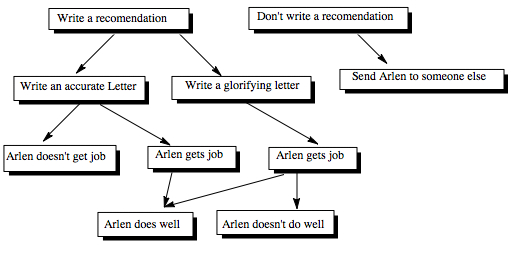Analyzing cases
In situations where an ethical decision is not always apparent, simple case analysis can provide insight as how to act. Just like the action of holding the door open for someone, a habit formed through repetition, a repetition of case analysis leads to an increase in the likelihood of making a good ethical decision. The moral analysis of a case can begin by suggesting answers to the standard questions a journalist might ask: "Who?" "What?" "When?" "Where?" "Why?" and "How?" Let's look at the Recommendation letter case.
We will start by asking Who?
- The characters involved are Terence Nonliquet, Leah Nonlibet and Arlen
Then we will ask when and where.
- Neither are pertinent in this situation
The remaining questions What, Why, and How are best answered using an event tree. An event tree lists possible actions and possible consequences of those actions. For this example, an event tree might look like:

The event tree shows all possible outcomes from different courses of action. Drawing an event tree of an ethical decision can often ease the choice by presenting all possible courses of action along with all possible outcomes. Then by listing the pros and cons of all possible outcomes, the decision becomes simpler. By viewing more case studies and applying this principle, it becomes easier to make a good ethical decision.

